Grand Canyon Smackdown: North Rim vs. South Rim

The Grand Canyon is by far one of the most popular tourist destinations in the United States. Attracting upwards of 5 million visitors per year, this steep-walled canyon is one of the most well-known natural wonders in the world. People flock to it from all corners of the globe to peer into its depths.
And for good reason. Because, even if you tend to shun “touristy” destinations, I'm willing to bet the Grand Canyon will blow you away.
It sure blew my socks off.


You can see this work of Mother Nature in photos and in movies. But, until you're actually standing on one of its rims and squinting down at the Colorado River a mile (yes, a mile!) below, you can't truly understand its magnitude.
The Grand Canyon does not just have one side or vantage point to awe you with, however. It actually has three distinct and different rims that you can visit: the South Rim (the most popular), the North Rim (the lesser touristed), and the West Rim (the newest to open to visitors).

But which one is the best? Which one should you visit if you can only visit one?
Well, the West Rim isn't actually contained within Grand Canyon National Park, and I've never actually been there. But I have been to both the North and South rims (the South Rim multiple times!), so I can give you my take on those. They're the two rims people most often have to choose between anyway when visiting the Grand Canyon.
So, without further ado, let the Grand Canyon smackdown begin! We'll talk things like accessibility, views, prices, access to hikes, and more.
RELATED: 25 Things to Do in the Southwest USA to Put on Your Bucket List
Which side of the Grand Canyon should you visit?
1. Accessibility
The Grand Canyon is not exactly the most accessible tourist attraction. It's in the middle of nowhere in northern Arizona, and only has a couple of main highways that lead to it.
Even though the North and South rims are only about 17 miles apart as the raven flies, there's just one 220-mile driving route available to take you between the two sides that will take you roughly 5 hours to traverse.

North Rim accessibility
The North Rim is only accessible via Route 67, which branches off of Route 89A in the town of Jacob Lake, Arizona.
Due to the road often being impassable during the winter months, the North Rim is only open from mid-May through mid-October. Which is probably why it is much less visited.
It also isn't nearby any major cities/towns. The closest town of any size beyond Jacob Lake is Page, Arizona, a 2+ hour drive to the northeast.
South Rim accessibility
The South Rim, in comparison, is open and generally accessible year-round via Route 64 from either the east or the south. It is 1,000 feet lower in elevation than the North Rim, so the roads here are usually not closed due to snow in the winter.
Several Arizona towns are within 2 hours driving distance from the South Rim, including Williams, Flagstaff, and Sedona.
During the busy summer months, free shuttles run through this part of the park to help you reach popular viewpoints. Even if some roads are open to cars, it's still recommended that you park and use the shuttle service.
Smackdown winner: South Rim
Tally: North Rim — 0 South Rim — 1
RELATED: Yes, You Can Visit the Grand Canyon in Winter
2. Amenities
If you have your heart set on staying within Grand Canyon National Park during your canyon visit, good luck. Accommodations can be booked up to a year in advance in some cases, and they tend to fill up quickly.
Staying outside the park is often the best option.

North Rim amenities
Because the North Rim is only open for half the year, and because it's further away from any major settlements, there isn't much here by way of amenities.
There is only one accommodation option here that isn't a campground (there's one of those, too), and that's the Grand Canyon Lodge. The lodge is only open as long as the park is, and its bare-bones cabins book up months in advance. (Though, I will say that the lodge's remote location makes it pretty epic.)
South Rim amenities
The South Rim is home to Grand Canyon Village, which offers about 7 different lodging options at a variety of price ranges. There are also some campgrounds in the area, as well as smaller towns 15-30 minutes away that also have accommodation on offer.
The South Rim also has shuttles that will cart you around to the various viewpoints, and several restaurant options available year-round.

Smackdown winner: Draw. While the South Rim has more options, there is also more demand for them. The Grand Canyon Lodge at the North Rim is more rustic, and much less chaotic than Grand Canyon Village.
Tally: North Rim — 1 South Rim — 2
3. Viewpoints
The Grand Canyon isn't officially a Wonder of the World, but I think it should be. People come from all over the world just to look at it. In fact, the whole point of visiting is usually to just look at it and be in awe. The viewpoints, therefore, are important to consider.
North Rim viewpoints
The North Rim only has a few main viewpoints, including a couple that are only accessible via long, windy dirt roads that can take up to half a day to traverse.
However, the North Rim does boast the Grand Canyon's highest viewpoints, at over 8,000 feet. The most popular is Bright Angel Point, which is just a short walk from the Grand Canyon Lodge. From here, you can take in sweeping views of the canyon, and see all the way to the South Rim.

Other popular viewpoints are Point Imperial (the highest point on the North Rim at 8,800 feet) and Cape Royal (popular for sunsets).
South Rim viewpoints
The South Rim, on the other hand, has a ton of viewpoints, most of which are close together and easily reachable.
Starting near the east entrance of Grand Canyon National Park, there's Desert View – the first viewpoint in the park. Here, you can climb an old watchtower for stunning views out over the canyon.
Continuing on along toward the Grand Canyon Visitor Center and Grand Canyon Village, there are more than a dozen stunning viewpoints to stop at. Shuttles at the South Rim can take you to even more viewpoints that are not reachable by car.

You could spend an entire day just visiting viewpoints along the South Rim, and still probably not see them all.
Smackdown winner: South Rim, simply because there are more viewpoints.
Tally: North Rim — 1 South Rim — 3
4. The Views
But here's the point you're probably most interested in: which rim has the best views? Well, it's all subjective, of course. But here are my thoughts.
North Rim views
Even though the North Rim has fewer viewpoints, the viewpoints it does have are absolutely amazing. The colors of this side of the canyon are rich and vibrant. I was amazed at the layers of red and white present in the steep canyon walls, speckled with the dark green of trees and shrubs.
Bright Angel Trail leads you right along the edge of the canyon here, making it feel like you're actually IN the Grand Canyon. It was the North Rim that made me really realize just how huge and deep the Grand Canyon is really is.
South Rim views
The South Rim also has great views, of course, and each viewpoint offers up a slightly different angle.
The colors weren't as vibrant on the South Rim, though that could have been because the viewpoints didn't make you feel like you were IN the canyon like Bright Angel Point on the North Rim.
I've seen two sunsets at the South Rim, though, and sunset at any viewpoint on this side of the canyon is northing short of stunning.

Smackdown winner: Draw. The North Rim wins for color, but the South Rim wins for variety.
Tally: North Rim — 2 South Rim — 4
5. Number of Tourists
This item, to me, is the most important. Especially in the summer months, the Grand Canyon is such a popular destination. I hate having to jockey for position just to snap a photo, so the density of tourists is so important to mention here.
North Rim number of tourists
The North Rim sees, by far, the least number of Grand Canyon tourists (only 10% of all park visitors). Since it's more difficult to get to and less well-known, many visitors to the park simply skip the North Rim, heading straight for the South Rim instead. This means that the North Rim is blissfully empty, even during the busy summer season.
I visited on a slightly overcast afternoon in August, and there were only maybe a dozen other people out on Bright Angel Trail. There was no need to worry about someone getting in your photos, and there was no rush to move away from the edge of the viewpoints so others could get a look.
South Rim number of tourists
The South Rim, by contrast, is usually much more crowded. Which is not surprising, since this rim sees 90% of the Grand Canyon's tourists each year.
During busy times at the Grand Canyon (which is usually summer, and any times around holidays), it can be tough to find parking at the Grand Canyon visitor center, and the park shuttles can be packed.
If you want to avoid the worst of the crowds, you'll want to visit early in the morning, or later in the day (but probably not at sunset, as certain viewpoints get busy again). Or visit in the off-season, like in the winter, when there are fewer visitors.

Smackdown winner: North Rim, because it's much less crazy.
Tally: North Rim — 3 South Rim — 4
6. Access to hikes
While some of the long hikes, rafting trips, and helicopter/flightseeing tours at the Grand Canyon can begin at either side of the Grand Canyon, I did still want to briefly touch on the shorter day hikes you can find at each rim.
North Rim day hikes
At the North Rim, there are actually a large number of hiking options, many of which include forest trails and lead to canyon viewpoints. Some of these shorter rim hikes include:
- Bright Angel Point Trail, 0.5 miles – A short paved trail that leads to a stunning viewpoint.
- Cape Royal Trail, 0.6 miles – Another short, paved trail with canyon views.
- Roosevelt Point Trail, 0.2 miles – A short woodland loop trail with great canyon views.
- Transept Trail, 3 miles – Connects the Grand Canyon Lodge to the North Rim Campground.
- Uncle Jim Trail, 5 miles – Winds through the forest to a point overlooking the canyon and the North Kaibab Trail switchbacks.
The only trail from the North Rim that offers access down INTO the Grand Canyon is the North Kaibab Trail. In order to hike all the way down to the bottom of the canyon, you need multiple days. But you can take a shorter hike on this trail to the Coconino Overlook (1.5 miles) or the Supai Tunnel (4 miles).
South Rim day hikes
While many of the North Rim trails are forested, at the South Rim you'll find trails that follow the canyon rim or travel down into it. But the trails that go down into the canyon are steep and strenuous, and are not loop trails.
Day hikes on the South Rim are tougher, and require you to choose to hike just a portion of longer trails.
Popular day hikes at the South Rim include:
- Rim Trail, distance varies – The rim trail stretches more than 12 miles along the South Rim, from the South Kaibab Trailhead to Hermit's Rest. But because of shuttle stops all along the canyon rim, you can hike as little or as much of the Rim Trail as you'd like.
- Bright Angel Trail, distance varies – This is one of the more popular trails if you want to head down into the canyon; you can hike up to 12 miles of it in one day.
- South Kaibab Trail, distance varies – You have to take a shuttle out to this trailhead. A short hike on this trail offers up some of the best views available.
- Grandview Trail, distance varies – This trail leads to Coconino Saddle (2.2 miles), and Horseshoe Mesa (6.4 miles), but is very steep and difficult.

It's worth noting that you CAN hike at the South Rim during the winter months, but you'll want to be prepared with proper footwear to hike on snow and ice, as the National Park Service does not treat the trails.
Smackdown winner: Draw, because while the South Rim trails have better views, the North Rim trails offer a wider variety for all hiking levels.
Tally: North Rim — 4 South Rim — 5
7. Prices
The price to enter Grand Canyon National Park is the same no matter where you enter. However, some prices of popular activities differ from rim to rim.

For example, half-day donkey rides at the North Rim run $75 per person. These mule trips do not go to the bottom of the canyon, but still take you beyond the rim. At the South Rim, a 3-hour mule trip will set you back almost $120 per person.
Because the South Rim is much more popular, prices for some activities (as well as lodging and food) may tend to be a bit higher.
Smackdown winner: North Rim, because less demand means lower prices.
Tally: North Rim — 5 South Rim — 5
Final Tally: It's a tie!
…
Okay, so, going by these broad categories, the South Rim actually came close to winning. But, you know what? I actually liked the North Rim a lot, too, simply because it was so much less crowded and more natural.
For me, the sheer number of viewpoints at the South Rim (and the number of people at them) was overwhelming. I felt so rushed. I felt like all the other tourists, simply jumping out of my car to take some photos, and then dashing on to the next spot.
In order to truly “see” everything at the South Rim, you'd need more than just a day or two. At the North Rim, however, you can easily visit all the viewpoints in a day, and spend some time relaxing and just enjoying the view. And, to me, that sounds much more appealing.
However, if I have to give you advice, it would be to take the time to visit BOTH rims. Take a couple of days. Take your time. And then make up your own mind as to which rim is truly “better.”
READ NEXT: A Perfect 10-Day Itinerary for the American Southwest
Have you been to the Grand Canyon? If so, tell me which rim(s) you visited. If not, tell me which rim(s) you would most like to visit.
Pin it for later:

Amanda Williams is the award-winning blogger behind A Dangerous Business Travel Blog. She has traveled to more than 60 countries on 6 continents from her home base in Ohio, specializing in experiential and thoughtful travel through the US, Europe, and rest of the world. Amanda only shares tips based on her personal experiences and places she's actually traveled!


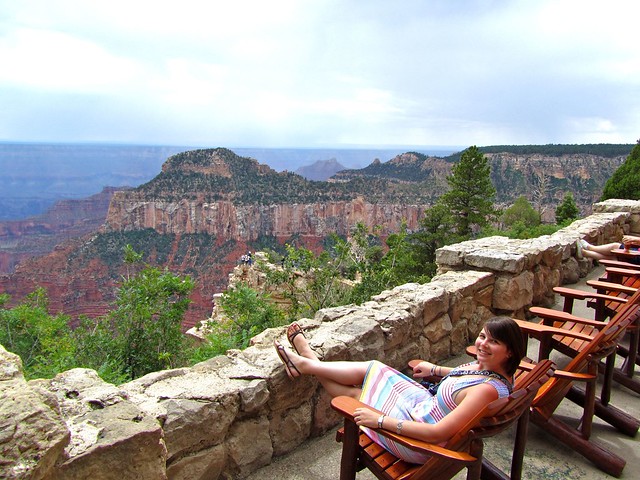
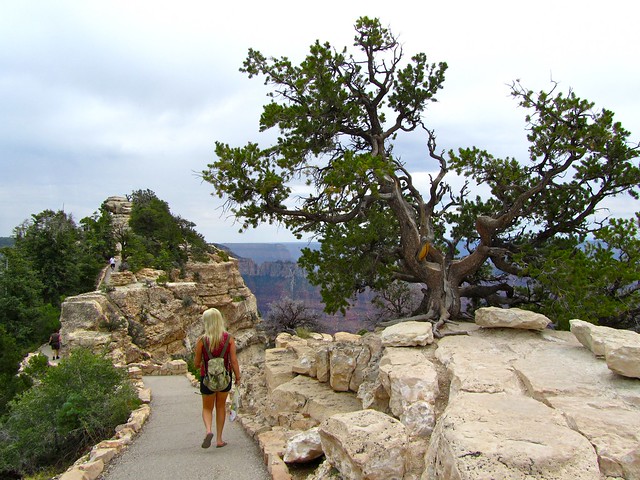
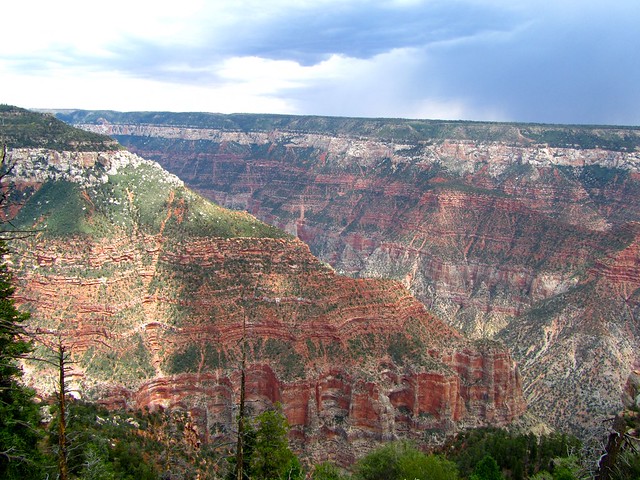
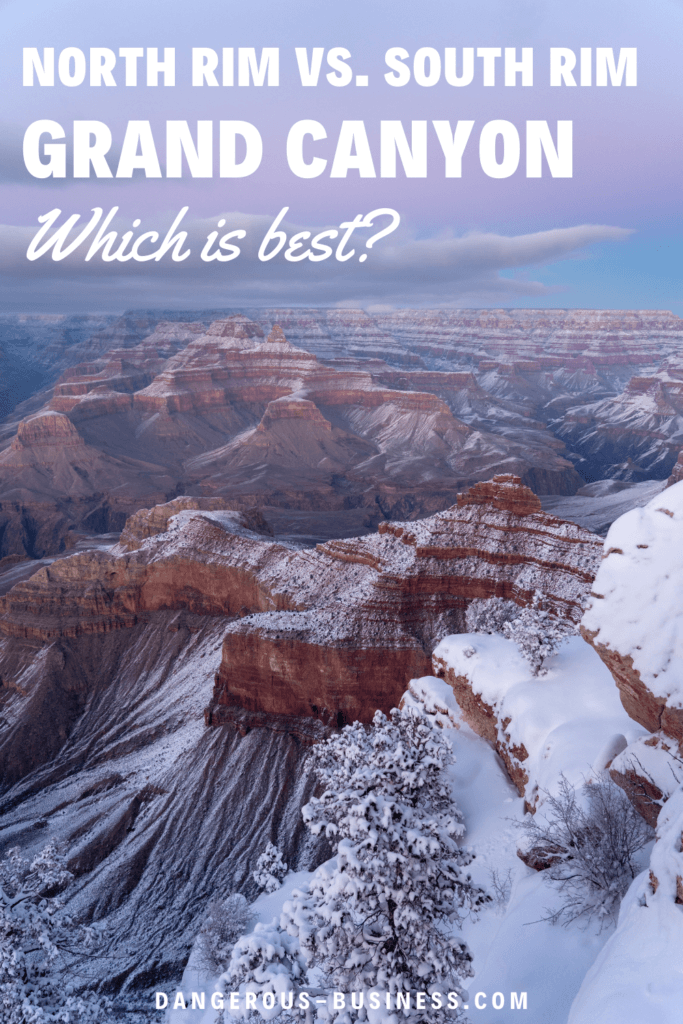
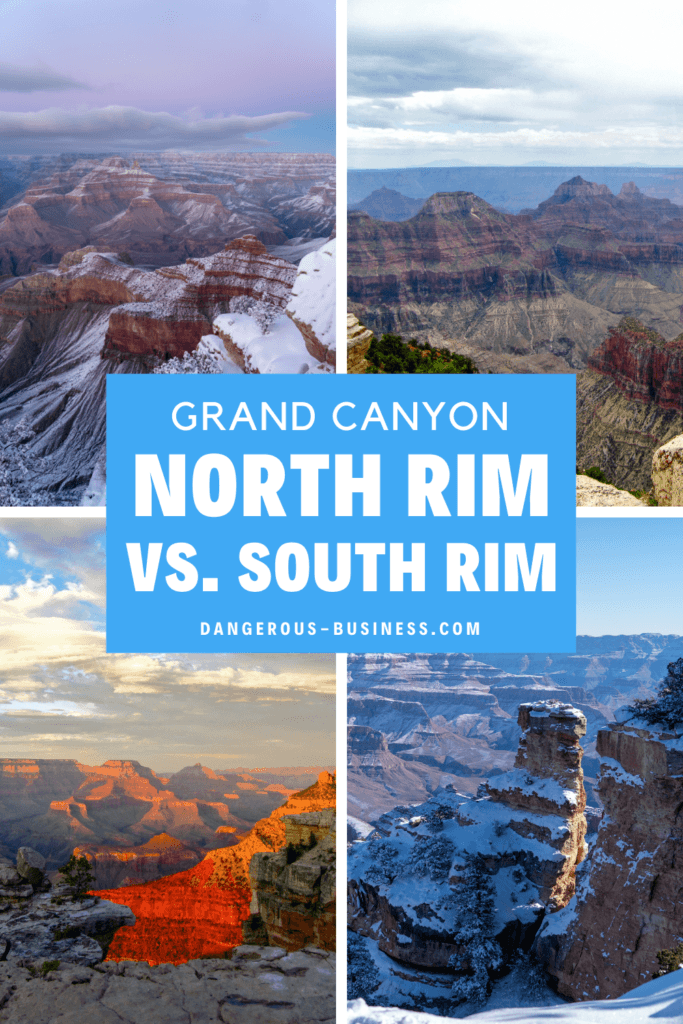
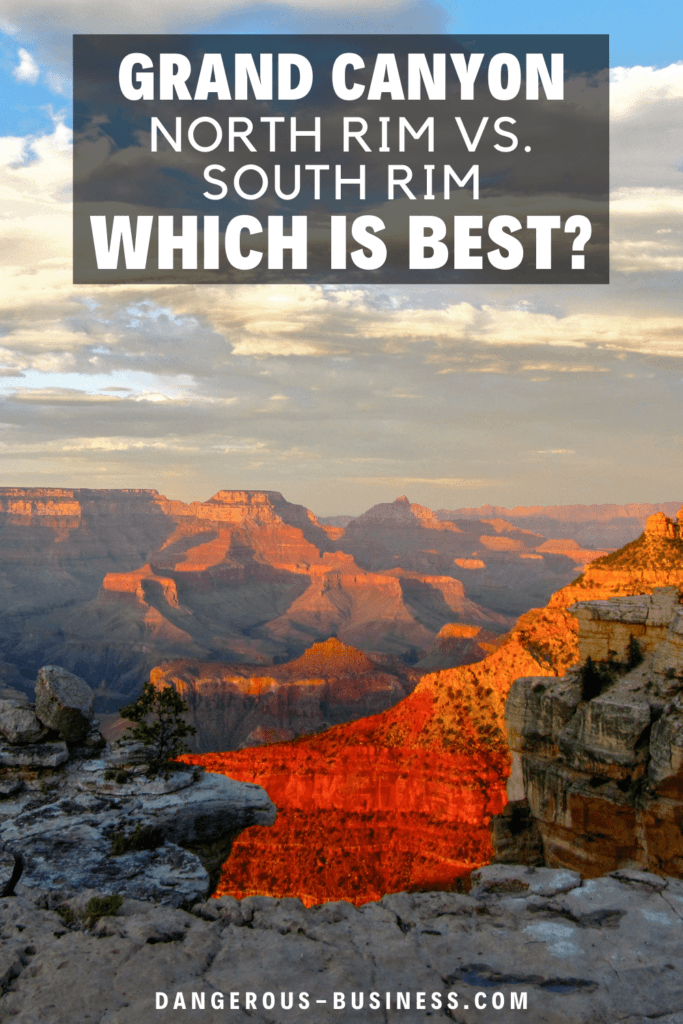









I have been to the Grand Canyon twice. Both times we camped in the Grand Canyon village Campground.(I believe that is what it was called). We were there for a week which was great but you can never spend enough time in or at the Grand Canyon. I remember a very, very long drive to the north rim and finding a place to eat. It was hunting season and I did not feel comfortable to be out and about! It was cold, and dreary weather totally unlike the south rim. It held no interest for me. Maybe it just was not a good time for our arrival?
I do want to ask what to expect if I only have one day to visit the south rim next March 2023? I do not think we can squeeze two days out of our trip as my daughter can only have two weeks off from her job. Our trip is in memory of her Dad and we wish to visit Lookout Point at sunset.
If you’re going in March you will indeed need to visit the South Rim, as the North Rim isn’t open that time of year. I have another post about visiting Grand Canyon in winter that you might want to read: https://www.dangerous-business.com/grand-canyon-winter/ In March, the weather really could be doing anything, so whatever you plan, make sure to pack some layers!
Been to both but my favorite is by far the North rim
Hi Amanda! I saw you mentioned the West Rim in your post. Have you had a chance to visit the West Rim of the canyon since writing this post? This is an awesome breakdown of the pros and cons of the South and North Rims of the canyon. As you said, the most accessible rims and the South and West rims. Most people have a hard time deciding which one to visit!
I haven’t been to the West Rim yet. Maybe some day!
Amanda, thank you for this great comparison of the Grand Canyon options. We have booked for the North Rim this summer and I cannot wait. We were pretty overwhelmed and slightly disappointed with the South Rim several years ago. After having visited several canyons lately, I have discovered that canyons should be experienced both above and below the rims. This time we will explore down into the canyon from the North Rim.
I hope you have a great trip, Janet!